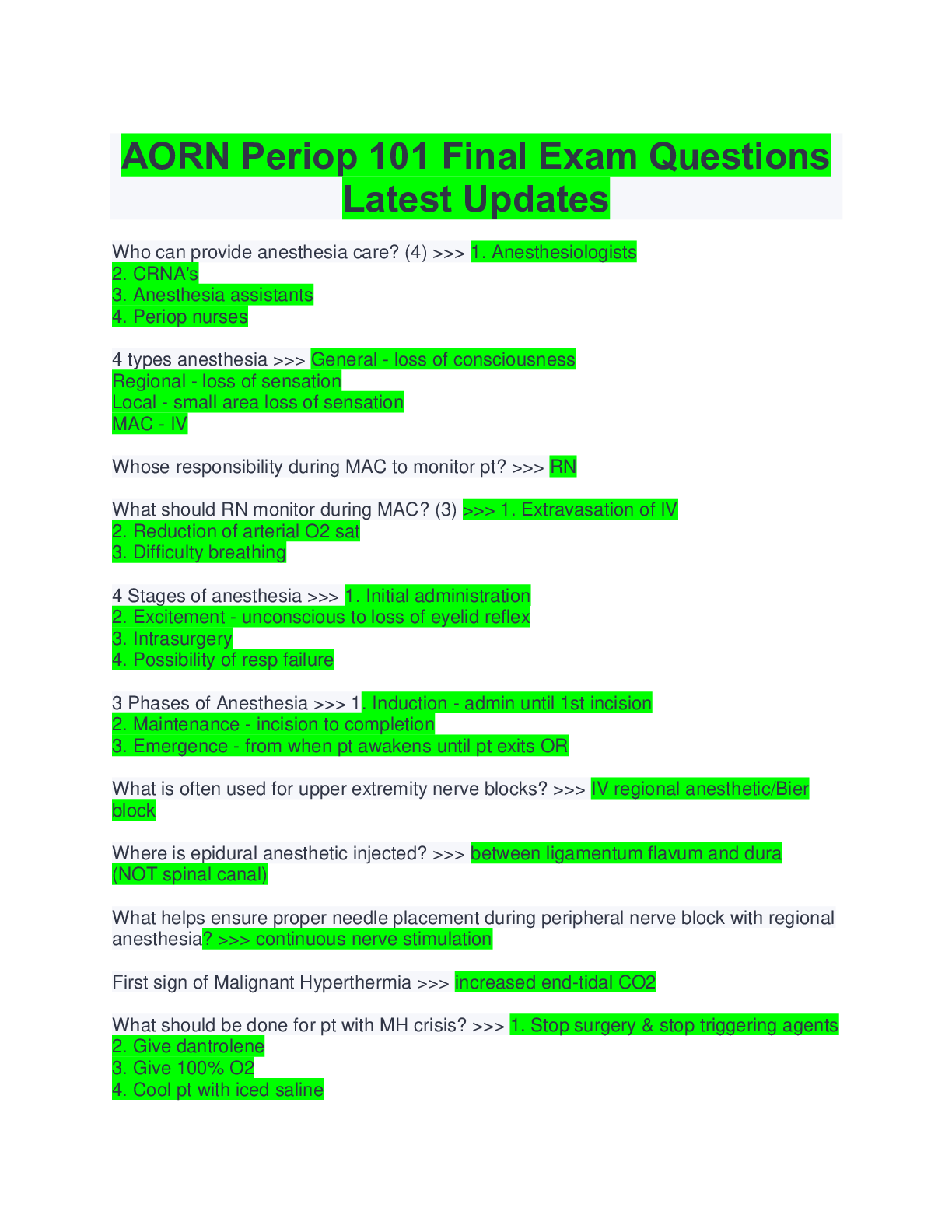*NURSING > QUESTIONS & ANSWERS > NUR 2356 / NUR2356 Multidimensional Care I Final Exam / MDC 1 Final Exam Review | Highly Rated Quiz (All)
NUR 2356 / NUR2356 Multidimensional Care I Final Exam / MDC 1 Final Exam Review | Highly Rated Quiz Bank| Questions and Answers | Latest 2020 / 2021 | Rasmussen College
Document Content and Description Below
MCD-1 Final Exam Study Guide Hygiene: Benefits of Bathing: Bathe clients to cleanse body, stimulate circulation, provide relaxation, and enhance healing. Bathe clients whose... health problems have exhausted them or limited their mobility Give a complete bath to clients who can tolerate it and whose hygiene needs warrant it. Allow rest periods for clients who become tired. Partial baths are useful when clients cannot tolerate a complete bath, need cleanings of odorous or uncomfortable areas, and can perform part of the bath independently. Therapeutic baths are used to promote comfort and provide treatment. Giving a Bed Bath: Collect supplies, provide privacy, explain procedure, apply gloves. Lock wheels on the hospital bed and adjust the height to a comfortable working position. Place a blanket over the client, and remove gown. Obtain warm bath water. Start by washing clients face first and allow client to perform this task if able. Perform the bath systematically by starting with the client’s trunk and upper extremities and continuing to the lower extremities. Keep clean area covered with a blanket or towel. Wash with long, firm strokes from distal to proximal and light strokes over lower extremities for clients who have a history of deep vein thrombosis. Apply a lotion and powder (If needed) and a clean gown. Replace water if he becomes cool, and use fresh water for perineal care. Document skin assessment, type of bath, and the clients response. Oral Hygiene: • Proper oral hygiene helps decrease the risk of infection, especially from the transmission of pathogens that can cause pneumonia. • Other populations who require meticulous oral hygiene include those who are seriously ill, injured, unconscious, dehydrated, and have an altered mental status or limited upper body movement. Autonomy for a Client Requiring Oral Care? • Brush the teeth twice a day. • Use a soft toothbrush. • Moisturize oral mucosa and lips every 2 to 4 hours. • Use a chlorhexidine gluconate (0.12%) rinse twice a day during the perioperative period for patients who undergo cardiac surgery (adult patients). • Use mouthwash inside the mouth twice a day for adult patients who are on a ventilator. • Give the patients the oral supplies. Perineal Care: (Reduces Urinary Tract Infection) • Perineal care helps maintain skin integrity, relieve discomfort, and prevent transmission of microorganisms (catheter care). • Provide privacy, maintain a professional demeanor, remove any fecal materials from the skin. • Cleanse the perineal area from front to back (perineum to rectum). • Dry thoroughly. • *On a MALE client* Retract foreskin of male clients to wash the tip of the penis, clean from the meatus outwards in a circular motion, then replace foreskin. Skin Care: • Perform a daily inspection of the patient's entire skin. • Document and report any manifestations of skin infection. • Use moisturizers daily on dry skin and apply when skin is damp. • Keep moisture from prolonged contact with skin. • Dry areas where two skin surfaces touch, such as the axillae and under the breasts. • Place absorbent pads under areas where perspiration collects. • Use moisture barriers on skin areas where wound drainage or incontinence occurs. • Do not massage bony prominences. • Humidify the room. Skin Cleaning • Clean the skin as soon as possible after soiling occurs and at routine intervals. • Use a mild, heavily fatted soap or gentle commercial cleanser for incontinence. • Use tepid rather than hot water. • In the perineal area, use a disposable cleaning cloth that contains a skin-barrier agent. • While cleaning, use the minimum scrubbing force necessary to remove soil. • Gently pat rather than rub the skin dry. • Do not use powders or talc directly on the perineum. • After cleaning, apply a commercial skin barrier to areas in frequent contact with urine or feces. Foot Care: - Foot care prevents skin breakdown, pain and infection. - Foot care is extremely important for clients who have diabetes mellitus, and a qualified professional must perform it. Must be performed for clients with peripheral vascular disease, or immunosuppression to evaluate the feet and prevent injury. - Inspect feet daily, paying attention to the area between the toes. Use lukewarm water, and dry the feet thoroughly. - Apply moisturizer to the feet, but avoid applying it between the toes. - Avoid over-the-counter products that contain alcohol or other strong chemicals. - Wear clean cotton socks DAILY. - Check shoes for any objects that may harm the feet, Cut the nails straight across and use an emery board to file nail edges. Avoid self-treating corns or calluses. - Wear comfortable shoes that don’t restrict circulation, do not apply heat unless prescribed, and contact provider if any infection or inflammation appears. Sleep and Rest: o Adequate amounts of sleep and rest promote health. Too little sleep leads to an inability to concentrate, poor judgement, moodiness, irritability, and increased risk for accidents. Chronic sleep loss can increase risks of obesity, depression, hypertension, diabetes mellitus, heart attack, and stroke. Non-rapid Eye Movement (NREM): Muscles begin to relax, light sleep, etc. Rapid Eye Movement (REM): Vivid dreaming, about 90 mins after falling asleep, reoccurring. o Ask about sleep patterns, history, or any recent changes. o Client education: Establish a bedtime routine, exercise regularly 2 hours before bedtime, make sleep environment comfortable, limit alcohol, caffeine, and nicotine at least 4 hours before bedtime, limit fluids, and relax. Nutrition: Assessment: Number of meals per day, fluid intake, food preferences and amounts, food preparation, purchasing practices, history of indigestion, heart burn or gas. Allergies, taste, chewing, swallowing, appetite, elimination patterns, medication use, activity levels, religious, cultural food preferences and restrictions, and nutritional screening tools. Nursing Interventions: Assist in advancing the diet as the provider prescribes, instruct clients about the appropriate diet regimen, provide interventions to promote appetite (good oral hygiene, favorite foods, minimal environment odors.) Educate clients about meds that can affect nutritional intake, assist clients with feedings, individualize client preferences. Assist with preventing aspiration, provide therapeutic diets, administer and monitor enteral feedings via nasogastric, gastrostomy or jejunostomy tubes, maintain fluid balance, encourage oral intake of fluids. Ensure a fluid intake between 2000 and 3000 mL/day. Maintain adequate intake of protein and calories. Pain Management: Medication: Non-Opioid analgesics: Example is NSAIDS, treating mild to moderate pain. Opioid Analgesics: Treating moderate to severe pain, such as postoperative pain. Adjuvant Analgesics: Help alleviate other manifestations that aggravate pain, treating neuropathic pain. Patient-Controlled Analgesia: Allows clients to self-administer safe doses of opioids. Acute Pain- protective, temporary, usually self-limiting, has a direct cause and results in tissue healing. Chronic Pain: is NOT protective, ongoing or recurs frequently, lasting longer than 6 months and persisting beyond tissue healing. Nociceptive Pain- arises from damage to or inflammation of tissue. Usually throbbing, aching, and localized. Neuropathic Pain- arises from abnormal or damaged pain in nerves. Includes phantom limb pain, pain below level of spinal cord injury, and diabetic neuropathy. Bowel Elimination: Many factors can alter bowel function. Interventions (surgery, immobility, medications, therapeutic diets) can affect bowel elimination. Fiber requirement: 25-38 g/day. Fluid requirement: 2 L/day for females, 3 L/day for males from fluid and food sources. Laxatives: Soften stool Diarrhea: Is a bowel pattern of frequent, loose or liquid stools. Causes include- viral or bacterial gastroenteritis, antibiotic therapy, inflammatory bowel disease, irritable bowel disease. [Show More]
Last updated: 1 year ago
Preview 1 out of 88 pages
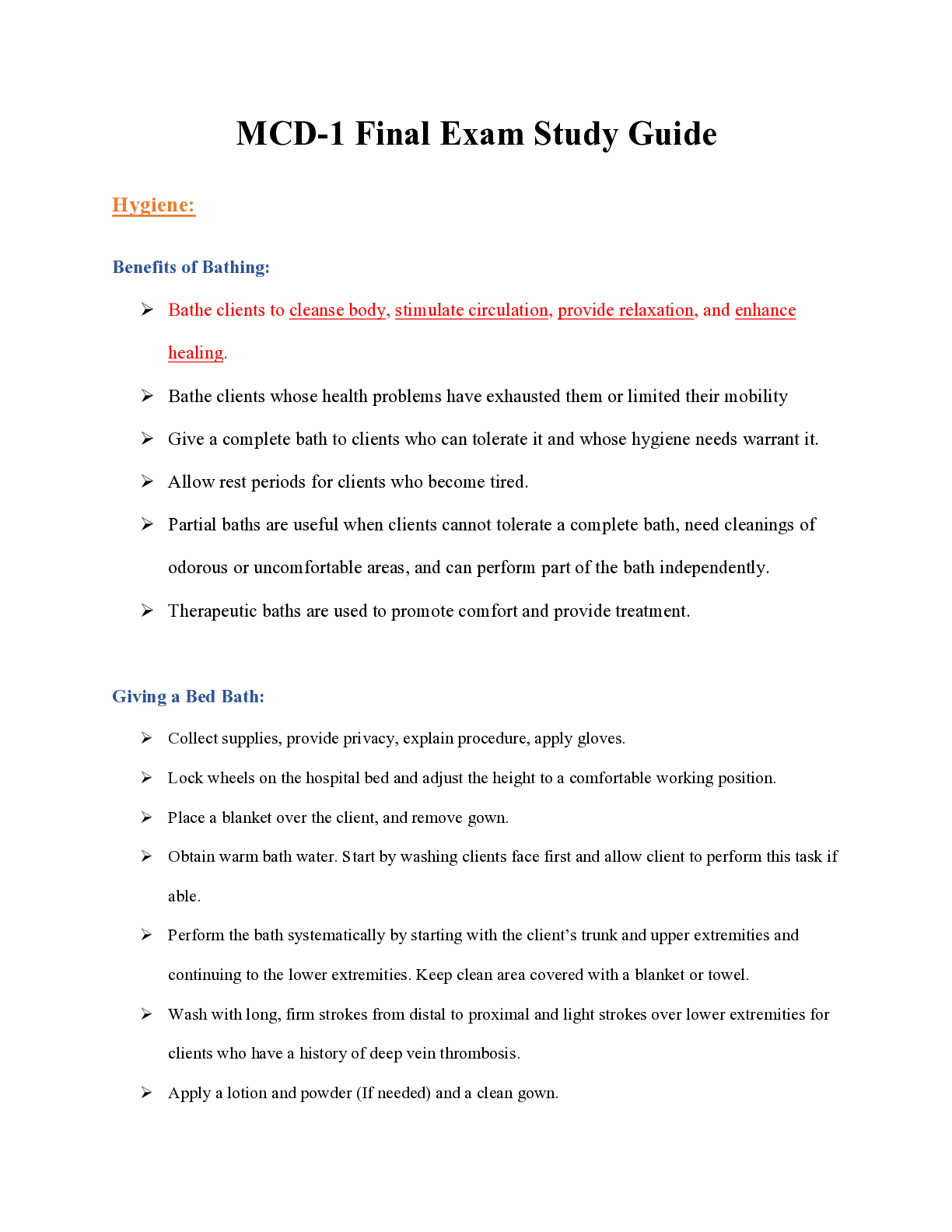
Reviews( 0 )
Document information
Connected school, study & course
About the document
Uploaded On
Sep 08, 2021
Number of pages
88
Written in
Additional information
This document has been written for:
Uploaded
Sep 08, 2021
Downloads
0
Views
38


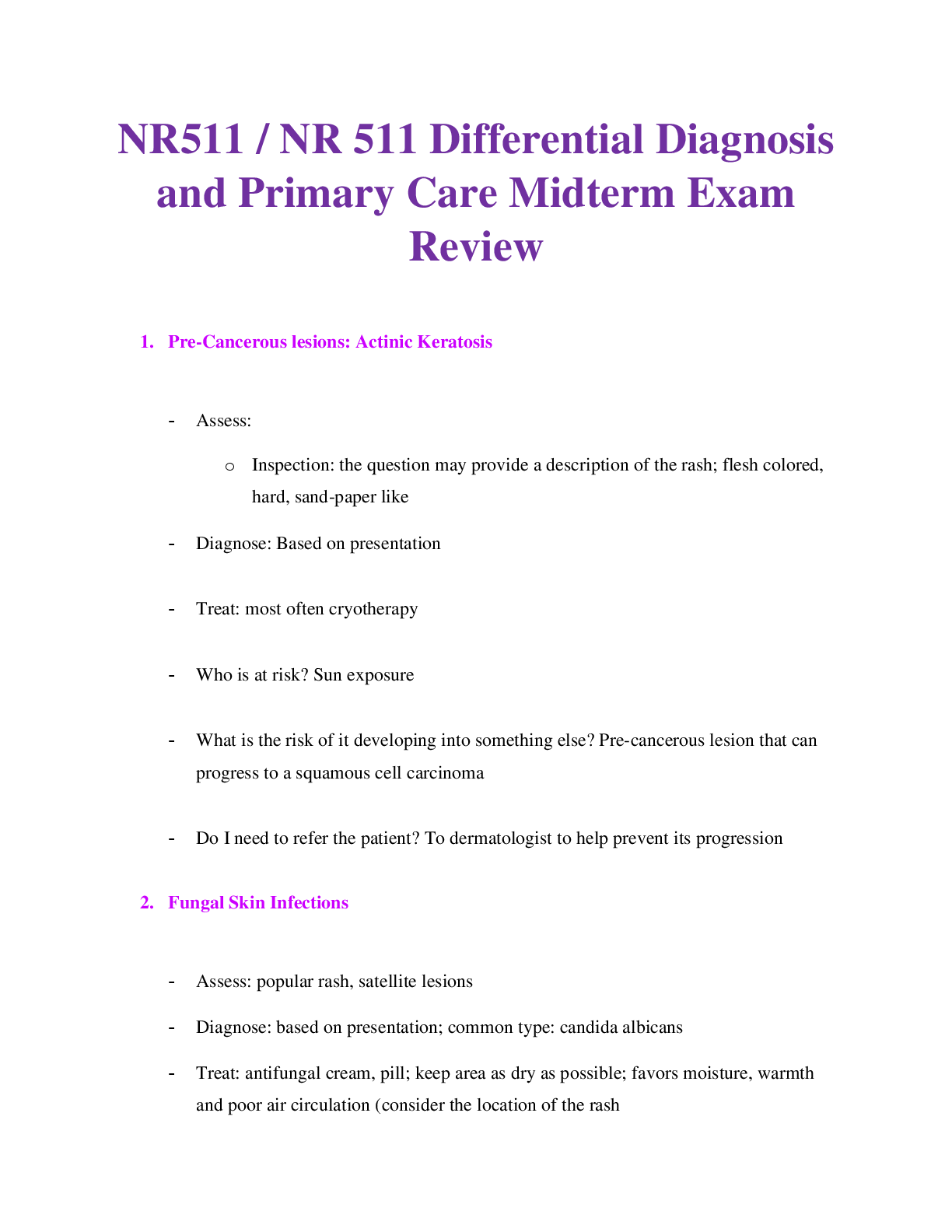
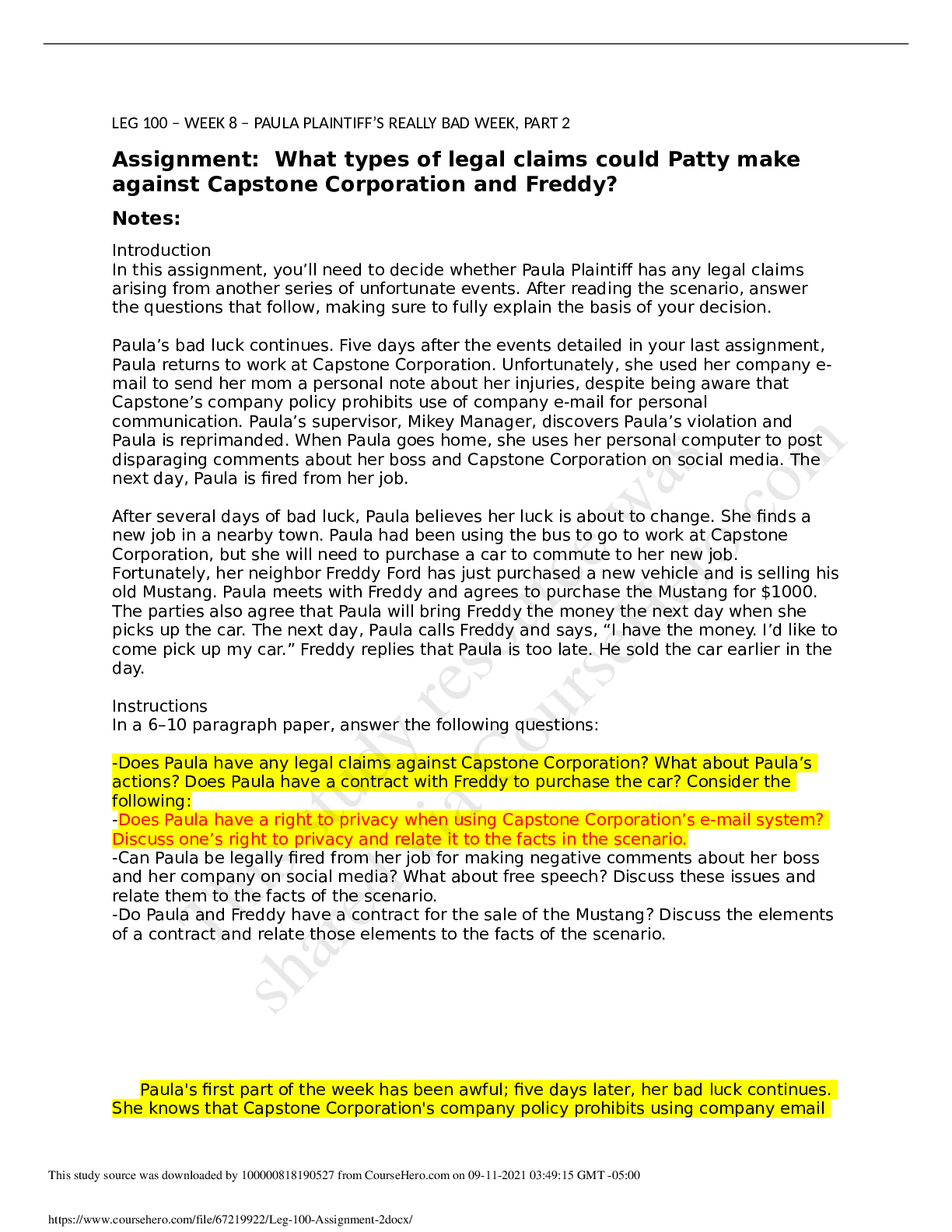
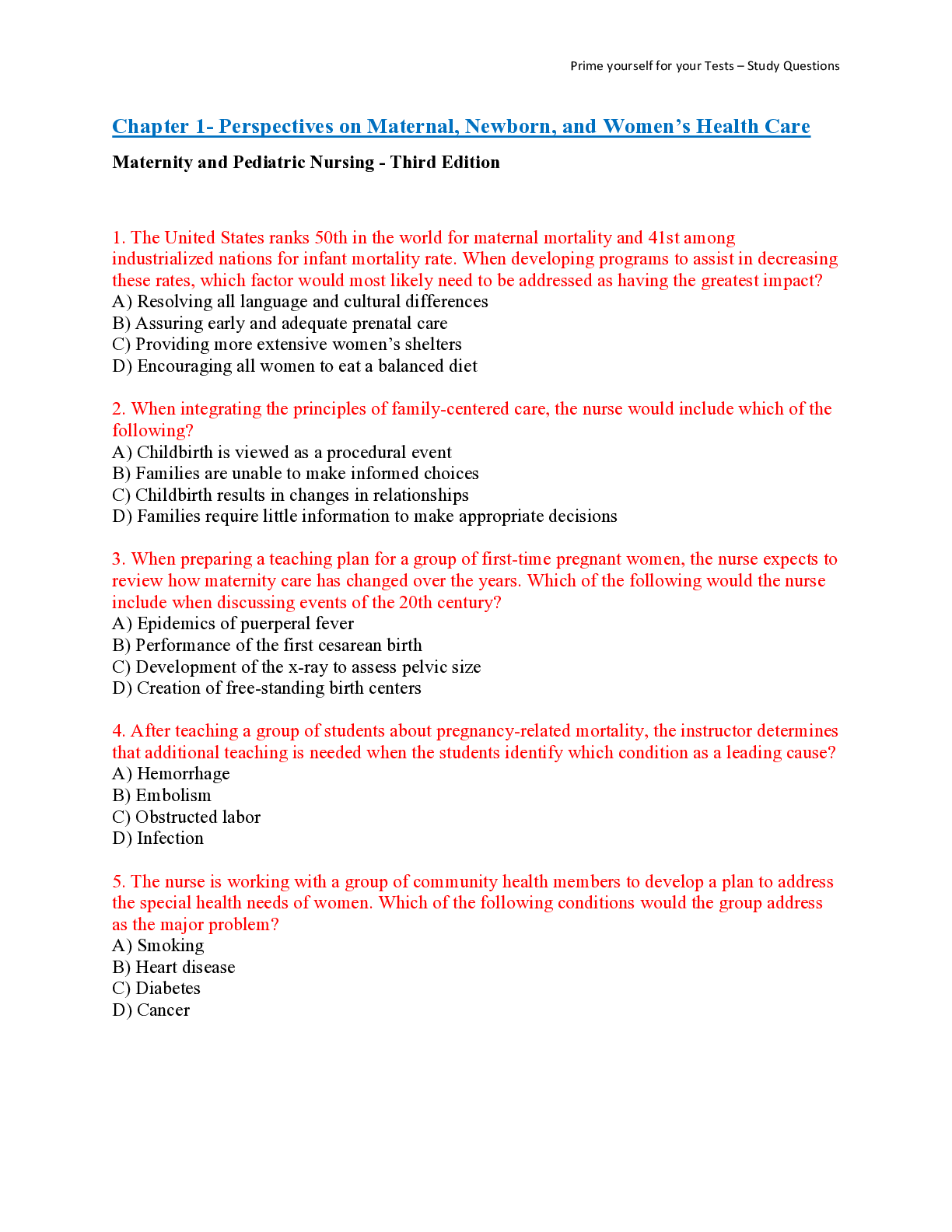
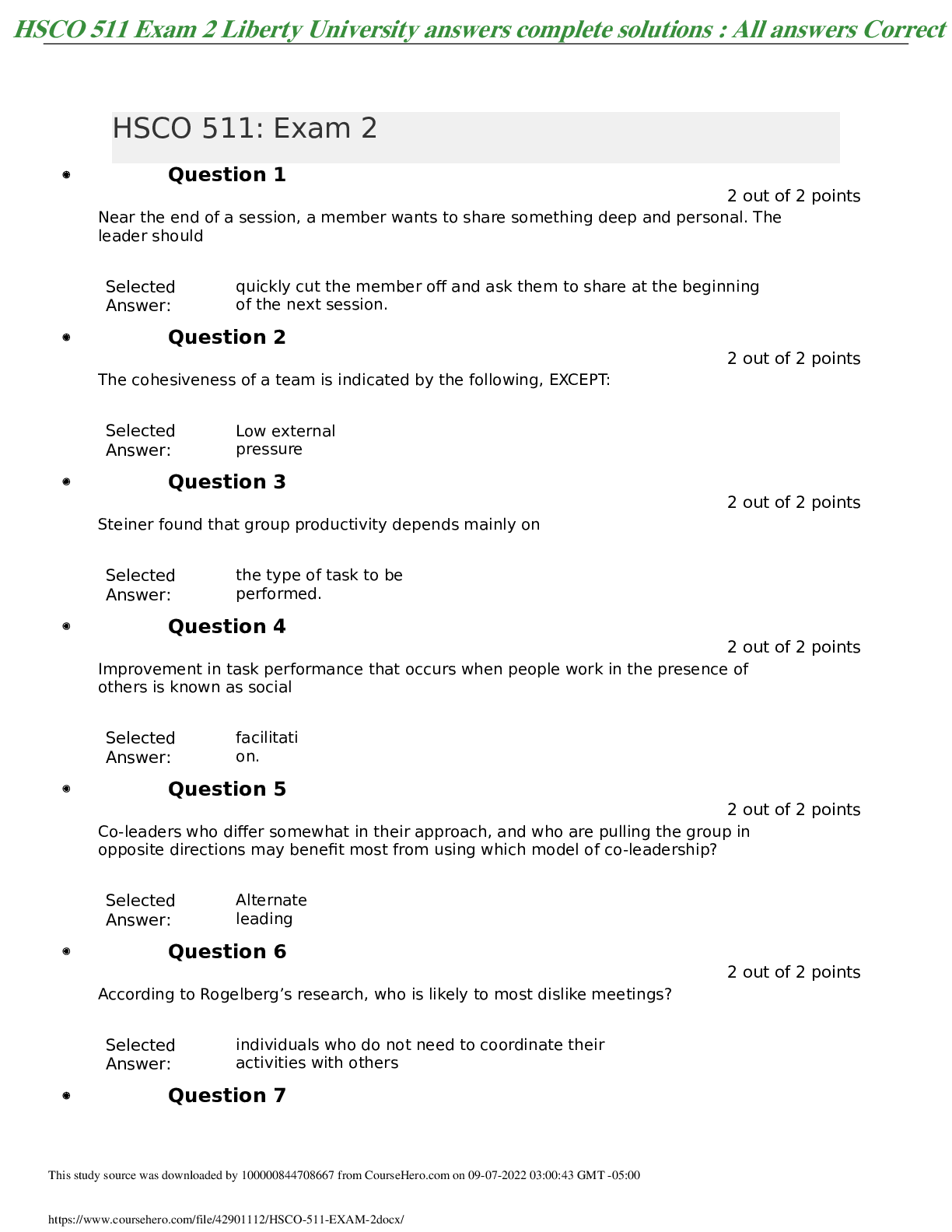
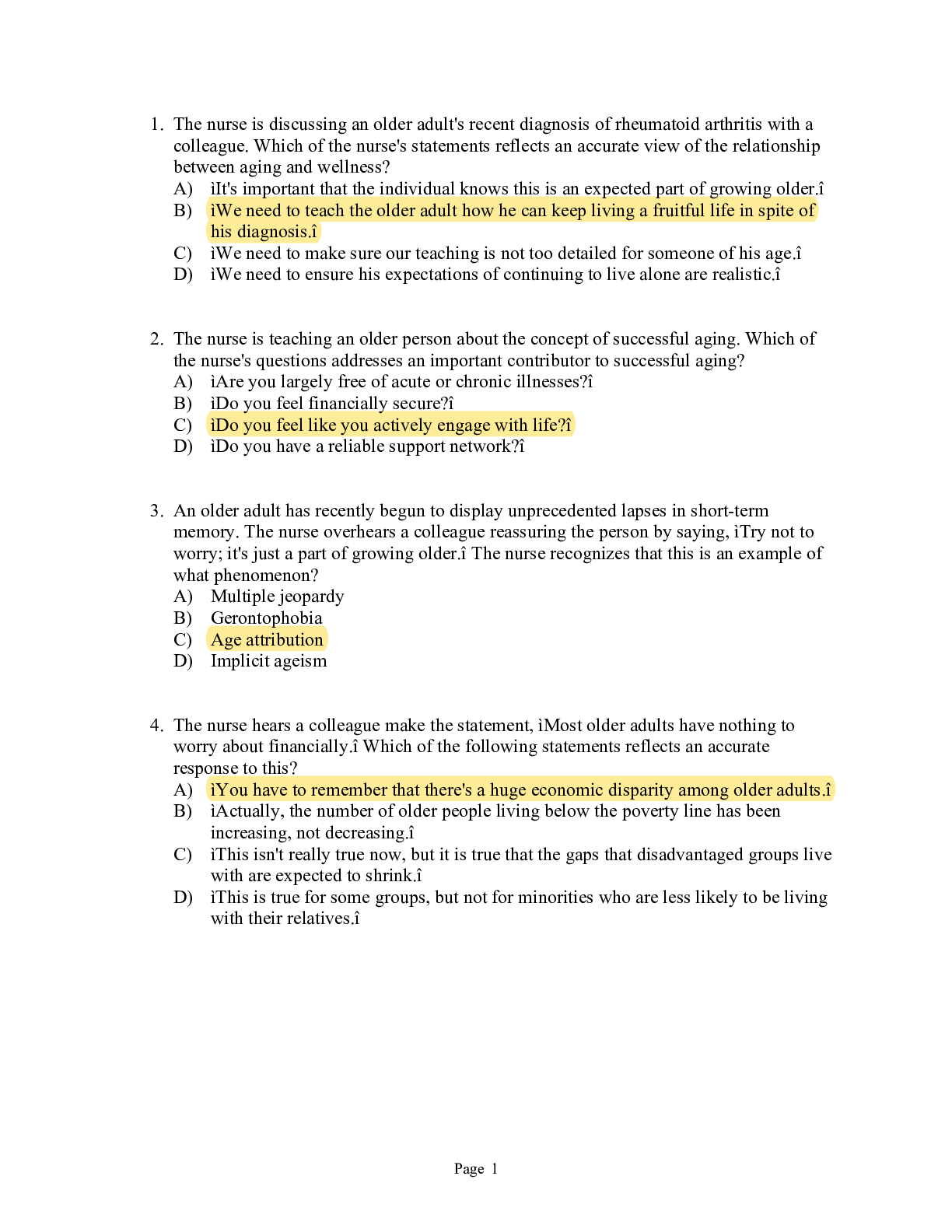

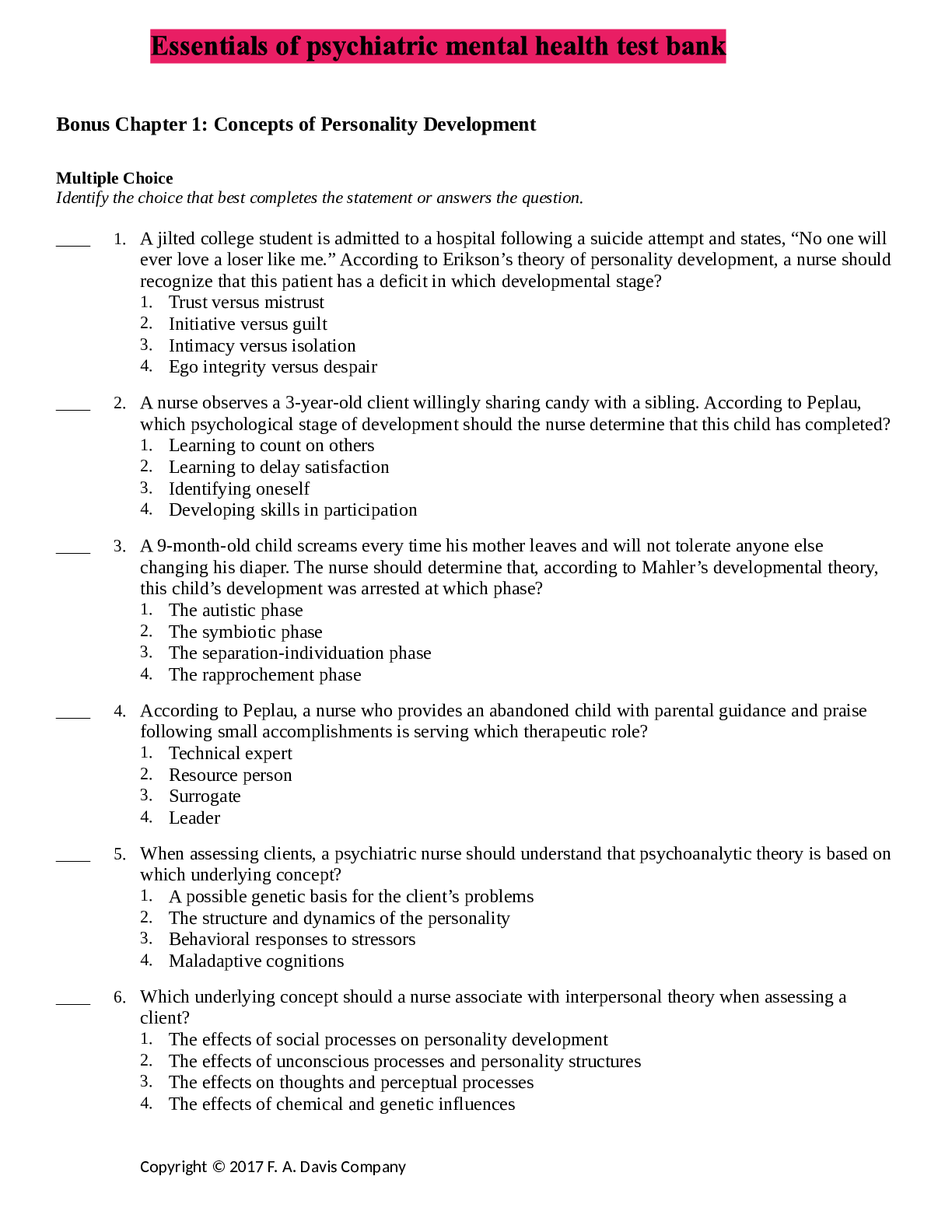
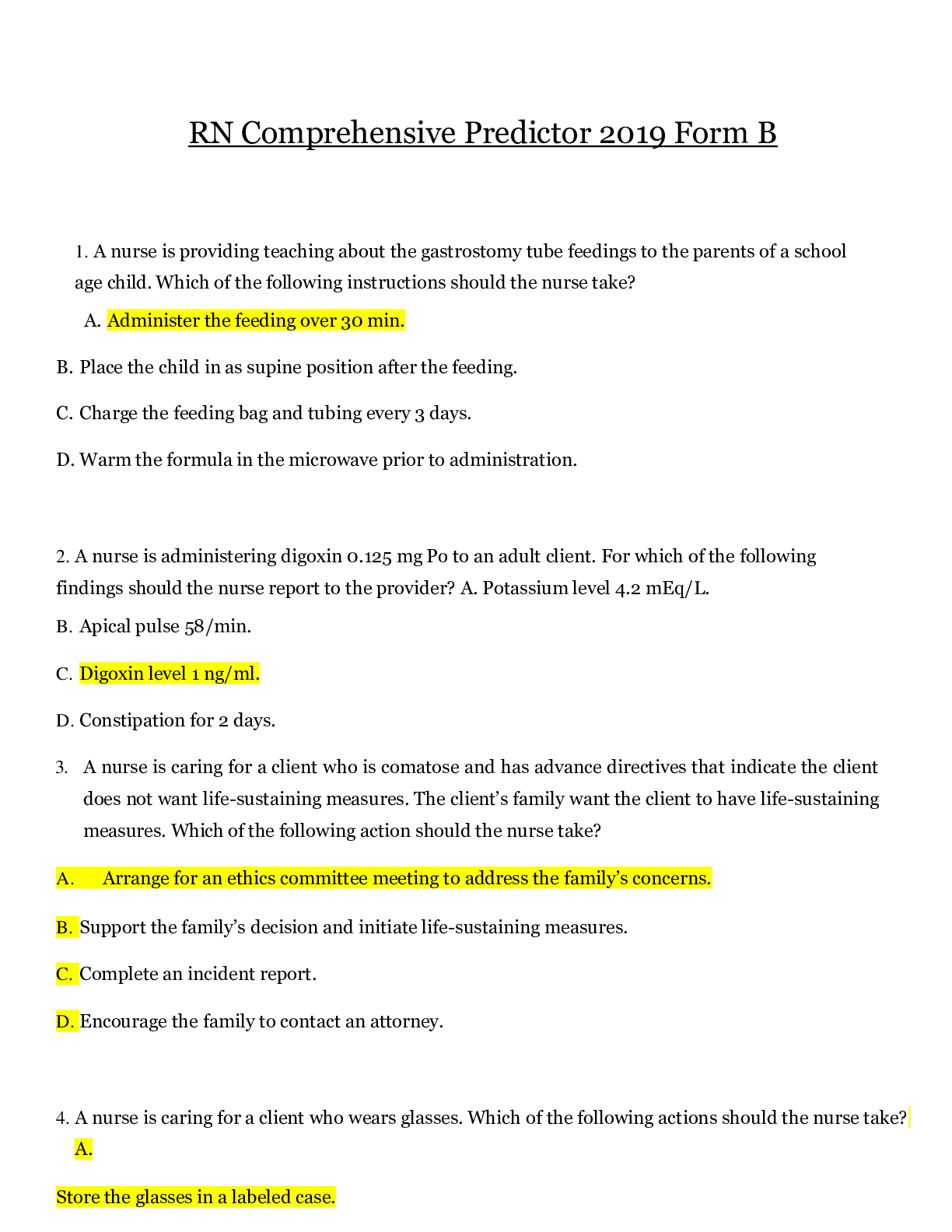

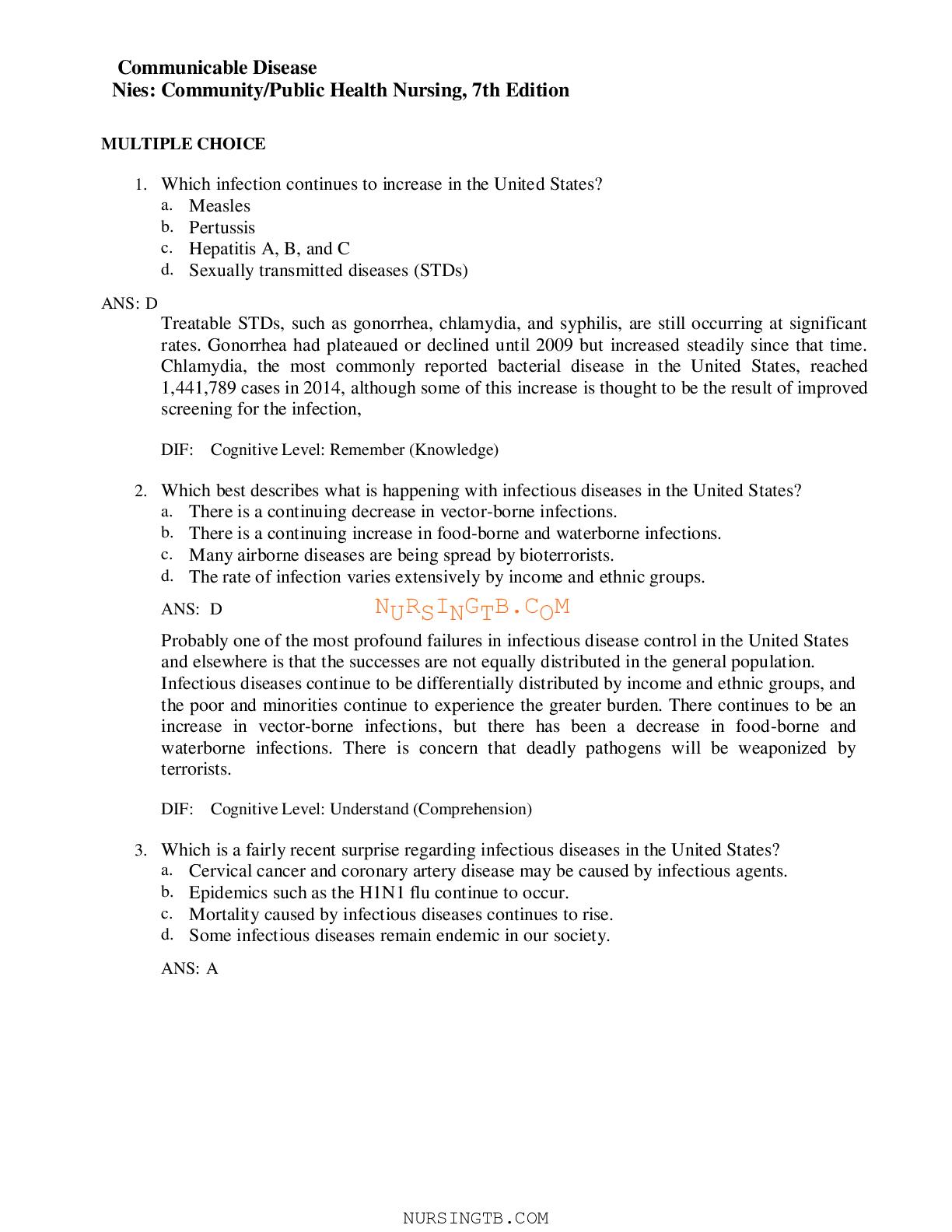
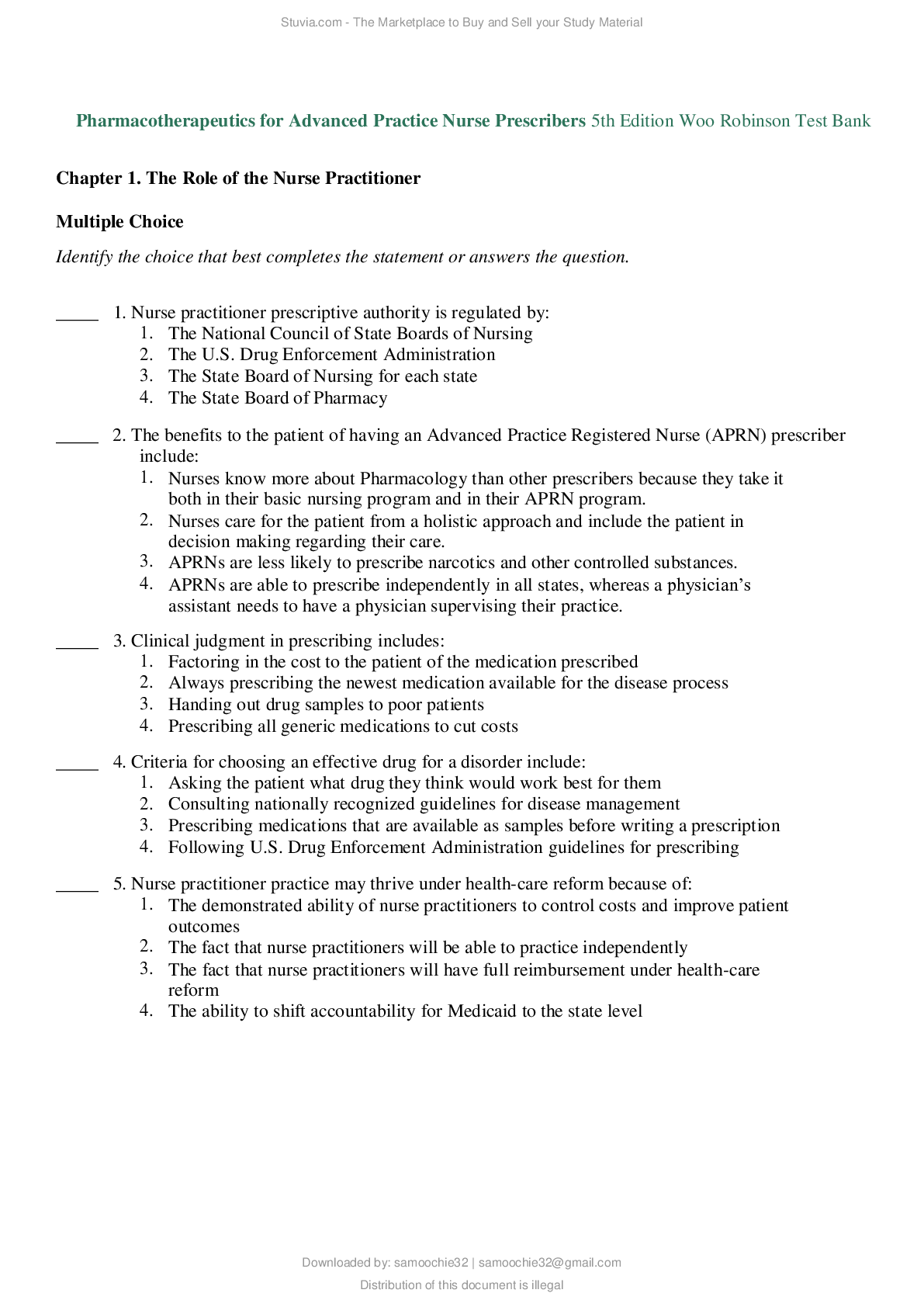
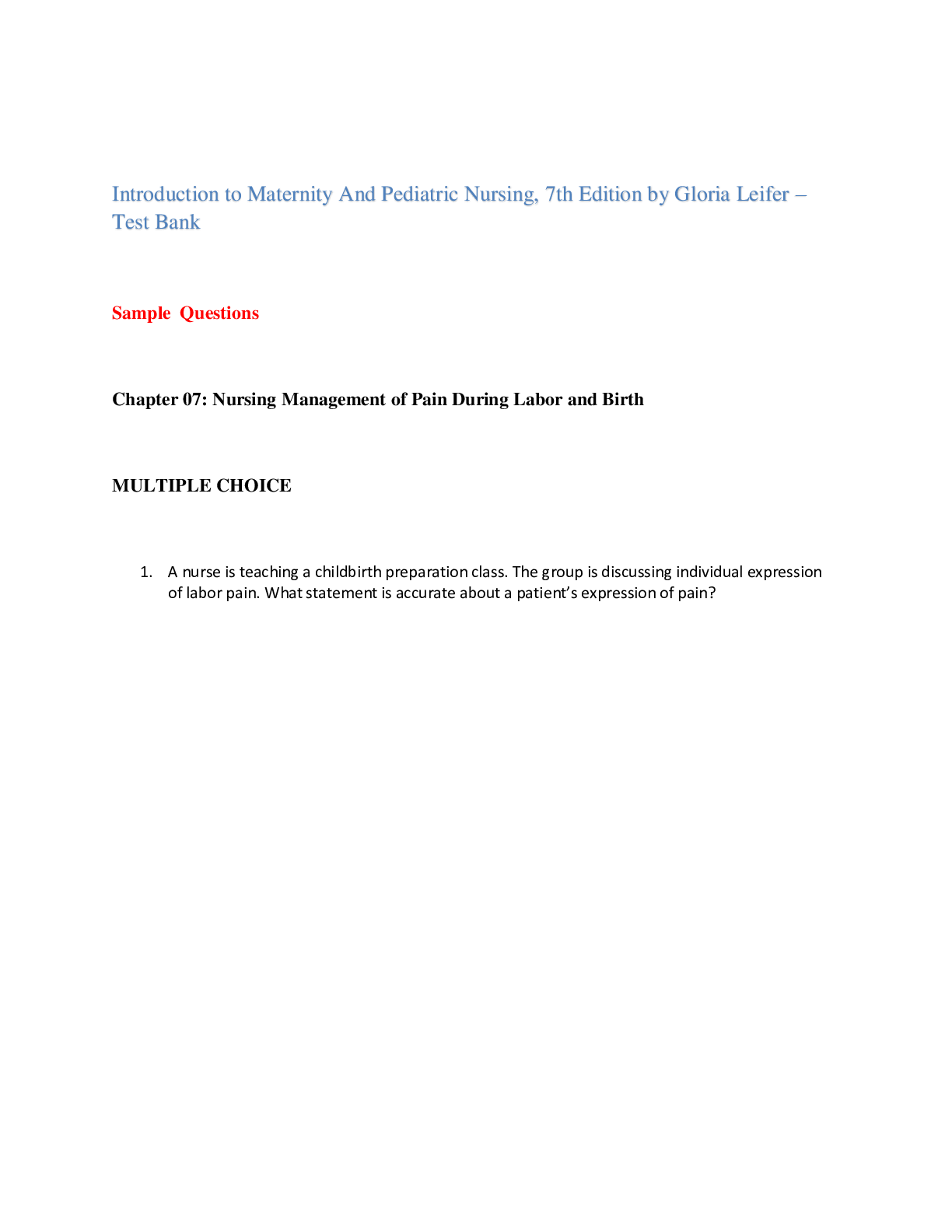
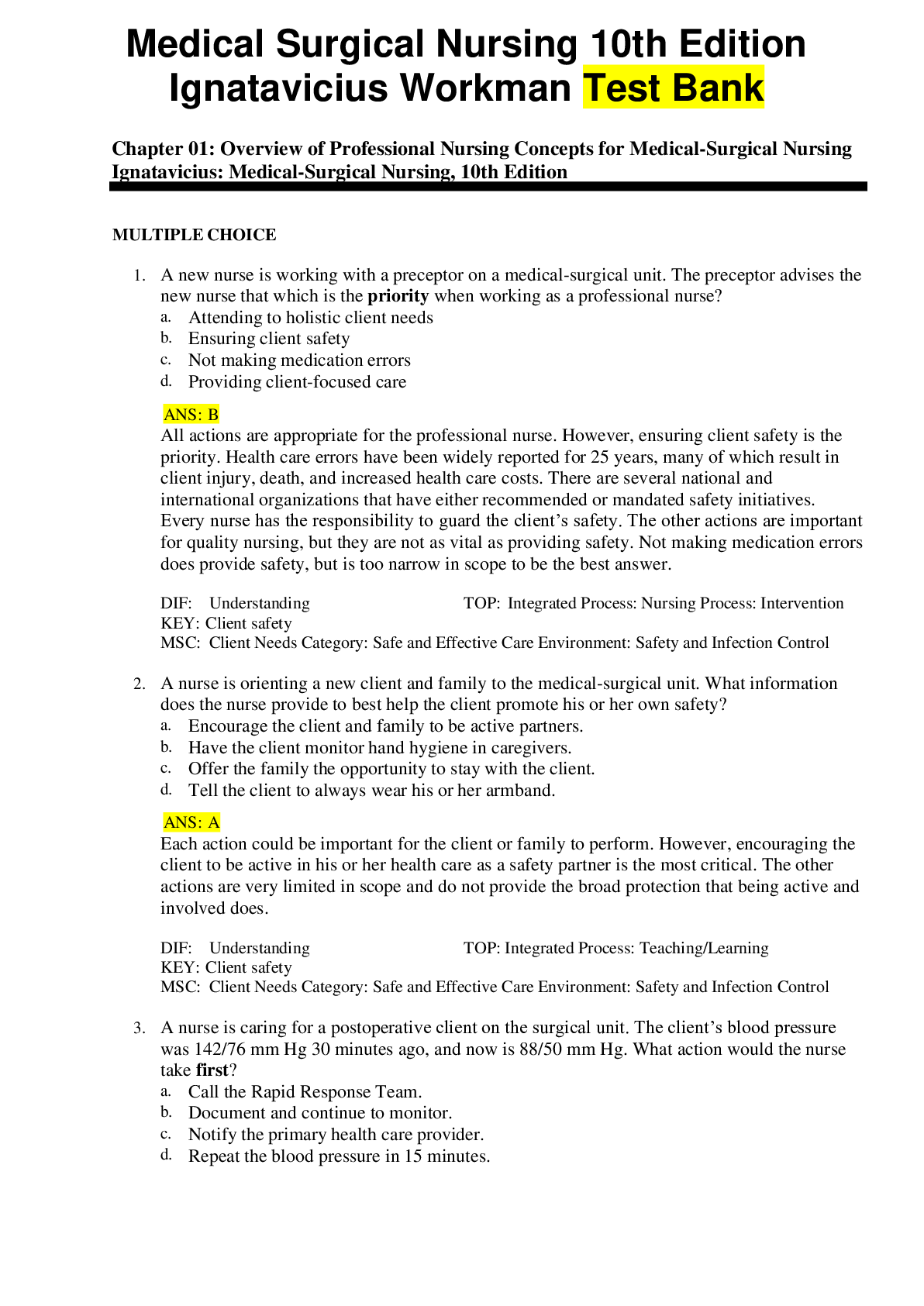

.png)
.png)
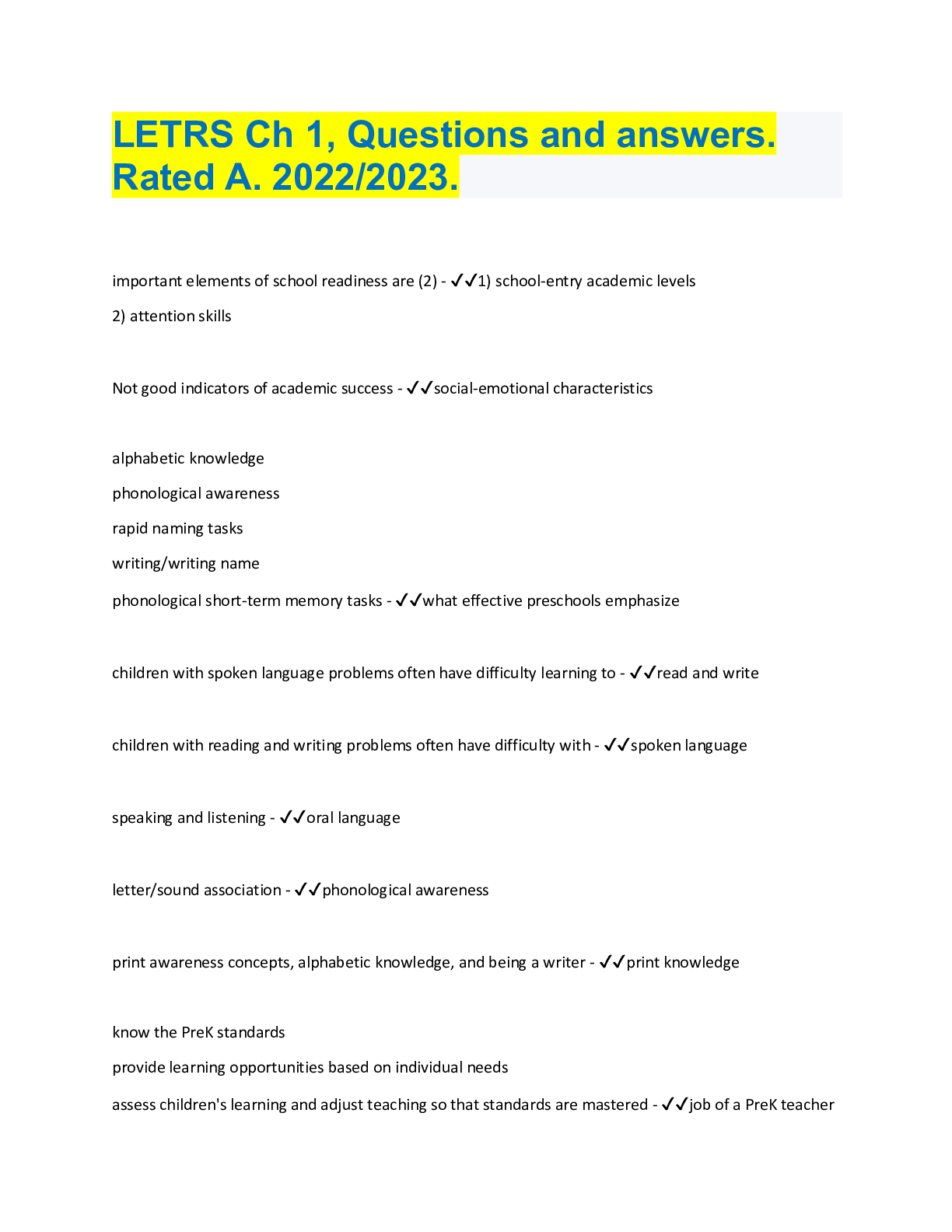
.png)
.png)
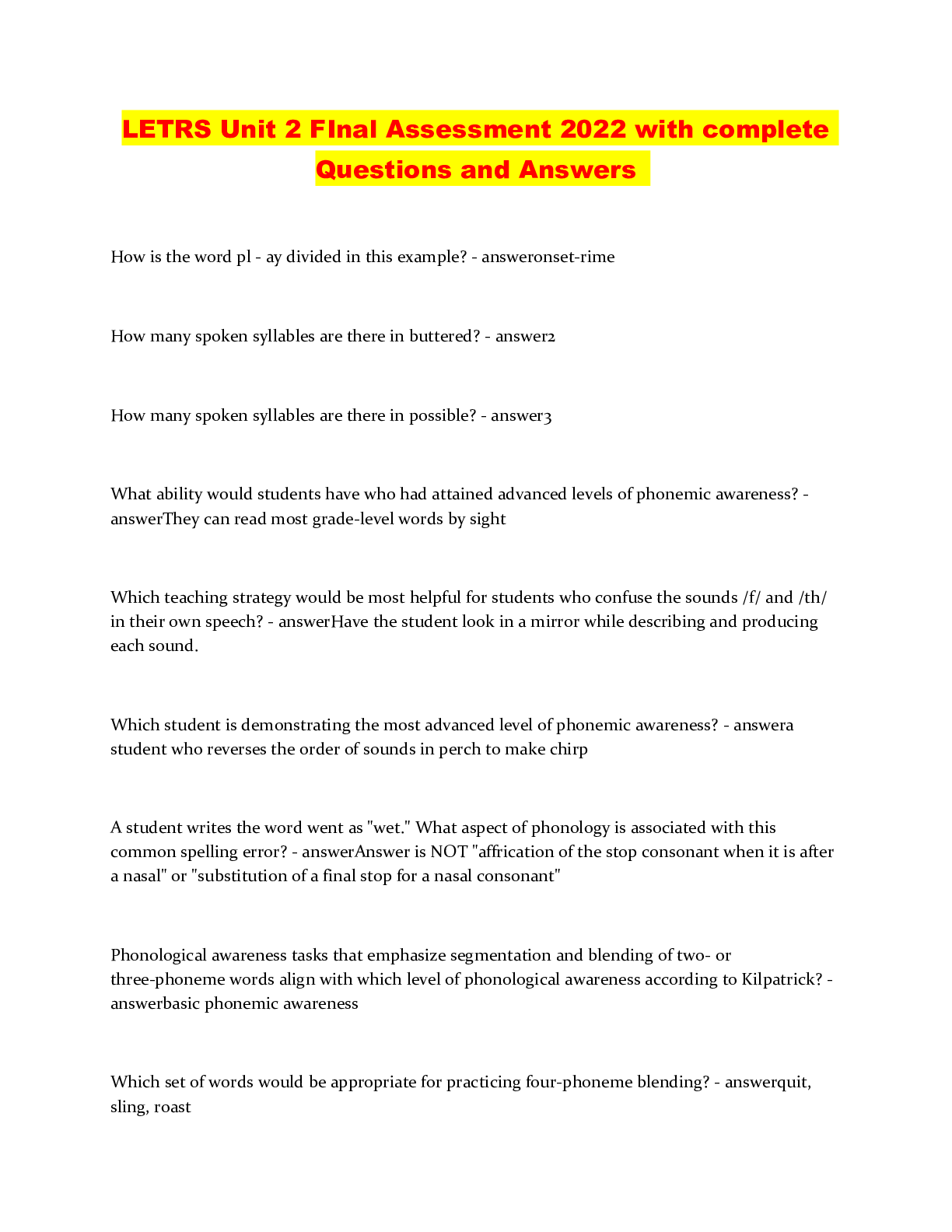


.png)
.png)
.png)
.png)
.png)

